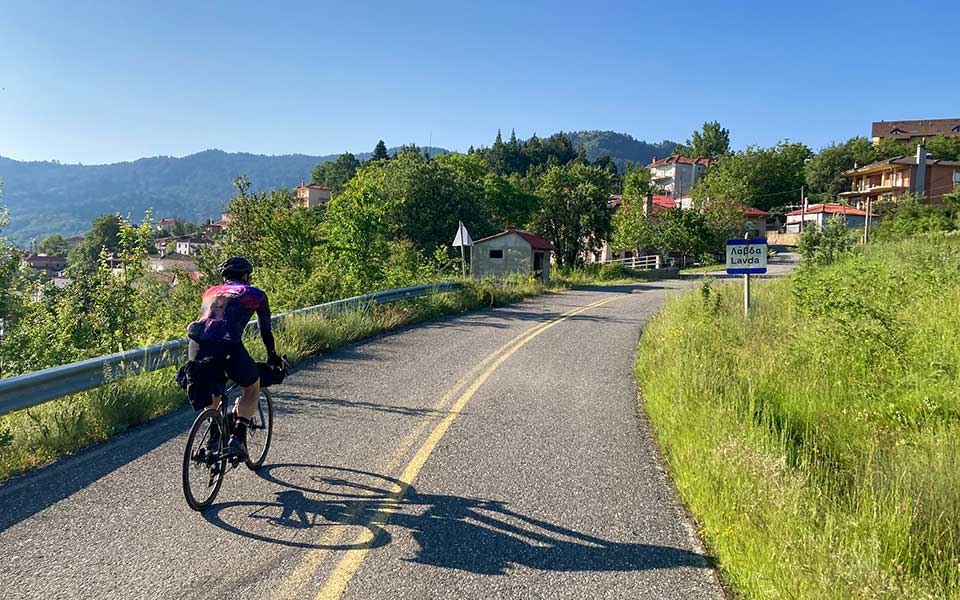I always come back to Pindus, one way or another. However, I had never explored Pindus by bike before. So, when the opportunity presented itself, it naturally intrigued me. The plan foresaw a trip around Mount Pindus, following only asphalt routes, that would begin and end in Kalabaka.
The trip was organized by the “Aghioi” (“Saints”), an amateur biking team from Aghioi Anargyroi that organizes weekly trips around Attica, as well as bigger tours every year. The “heart” of the team is Grigoris Papakanderakis, who has been an ardent supporter of bicycles as an alternative means of transportation and recreation from the first years of the crisis that hit Greece in 2010, when interest in bicycles saw a sudden boom and became a permanent fixture on Greece’s road map.

Katara: The legendary pass
We leave our cars at Kalabaka and our six-member group heads west. We quickly make our way up towards the village of Kalomoira, as the afternoon heat beats down on us. We stop at the square for a sandwich, where our presence quickly turns into a news article on a local site. We fill our water bottles and continue on, riding up and down hills, towards Ampelochori and then Panagia. There, we get off the unfrequented road and get on the busier Trikala – Ioannina road until the Egnatia Odos junction.
The road sign shows a right turn towards Katara, but two trucks that have unloaded dirt on the road make us question whether the legendary route is open. We decide to ignore the ominous sign and begin the long ascent through lush fir forests. The road, which today is used less and less due to the construction of Egnatia Odos, has become a “museum.” The vandalized coffee shops and deserted snow stations remind us of a time when this route was the top story on the news due to the heavy snowfalls that made the passage impossible.
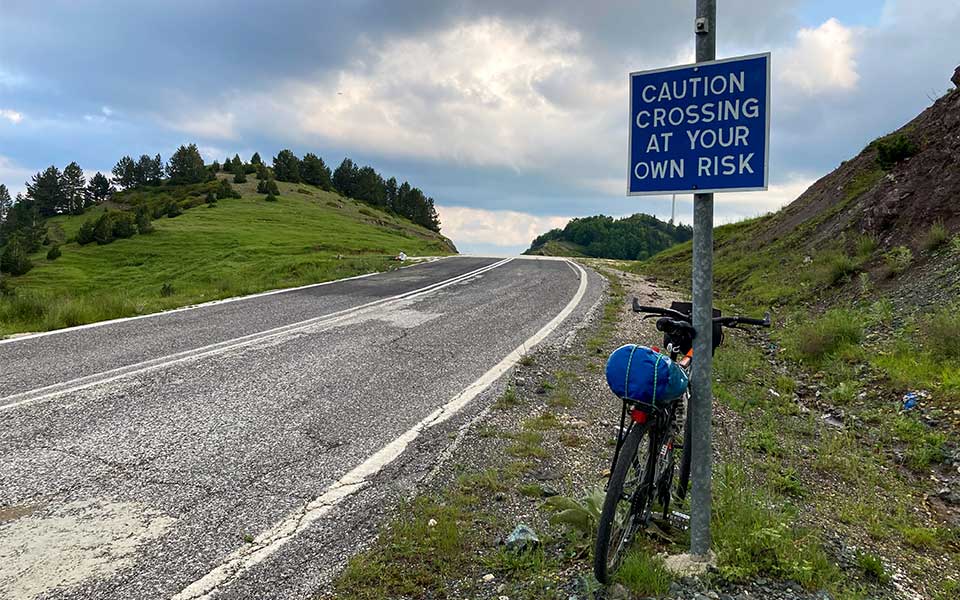
© Giorgos Detsis
Today, Greece’s “Route 66” looks haunted, tucked away in the solitude of the surrounding mountains. Avoiding the rocks that have fallen from the landslides, we reach the neck of Katara. A road sign warns us that we can pass at our peril. We take a moment to wonder at the “sea” of mountain peaks and continue on pedaling westwards, entering Epirus. We reach Metsovo in the evening, the home of the great shepherds and an area steeped in history as it was a hub for caravans that travelled to Central Europe during the Ottoman empire.
The area has many places of cultural and gastronomic interest, such as the Averoff Museum of Neohellenic Art that hosts significant paintings, the cheese factory of the Baron Michael Tossizza Foundation that produces the famous smoked metsovone cheese and the unique Katogi Averoff winery with its beautiful hotel. We stay overnight at the Hotel Galaxy, which has maintained its traditional character without any needless luxuries. At the hotel’s restaurant we review our first day, assessing our strengths and going over the route of the following day.
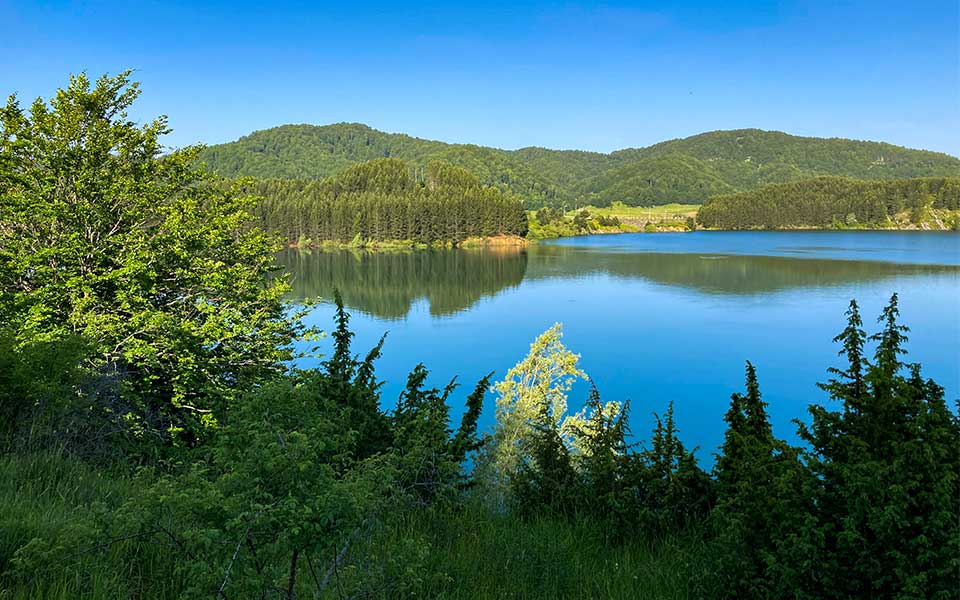
© Giorgos Detsis
Aoos Lake
We start our day bright and early with a hearty breakfast and a short warm-up before leaving Metsovo, which is still asleep, cycling through the evergreen plateau that is filled with sheepfolds, while a herd of wild horses grazes in the morning sun. Unfortunately, however, wherever there is a sheepfold there are sheepdogs that aren’t happy to see us. We manage to avoid some of them, while others, lying listless in the middle of the road, barely open their eyes and simply ignore us. We reach the shores of the Aoos artificial lake, at an altitude of 1,350m.
Since 1991 when the dam was completed, the landscape has transformed into a Scandinavian fjord. The road descends through a forest of black pine trees towards a small, natural lake with water lilies. We take a short break before making our way up to the martyred village of Flambourari, a large part of which was burned down by the occupying Germans in 1943.
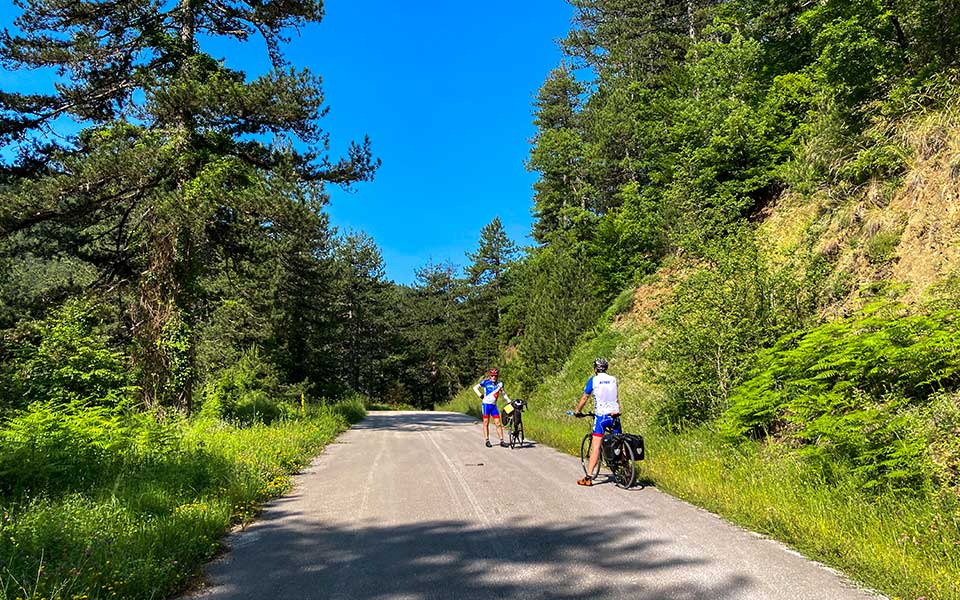
© Giorgos Detsis
Under the shade of a plane tree, we enjoy a coconut sweet preserve. Continuingon our route, we reach the Valia Calda mountain shelter at the entrance of the Pindus National Forest that provides accommodation and good food. If you have time, it is worth visiting the Arkoudorema tributary that flows into the Aoos River and the “Valia Calda” valley – the Vlach term for “Warm Valley.” For those who prefer something more comfortable, there is also the Kerasies stone guesthouse, located just a few kilometers away in Vovousa. In 1940, the Italian alpine brigade “Julia” was defeated here, marking Greece’s counter-offensive and triumph over the Italians as the latter were pushed back into Albania. Vovousa is a beautiful Vlach village whose inhabitants are involved primarily in logging. In the heart of Vovousa stands a single-arched stone bridge – a truly beautiful gem over the Aoos River – that connects the two sides of the village.
We get something to eat at Angelos’ taverna, which is open most months of the year and serves simple but delicious dishes on its balcony that has an incredible view of the river. A short siesta under the shade of the walnut trees next to the bridge is a must before beginning the arduous ascent through the Tizas pass that separates Epirus from Western Macedonia. Once we get through the pass, we make our way down to Perivoli on route to the village of Ziakas. There, we stay at the Hotel Villa Alexandra, a good and affordable hotel.
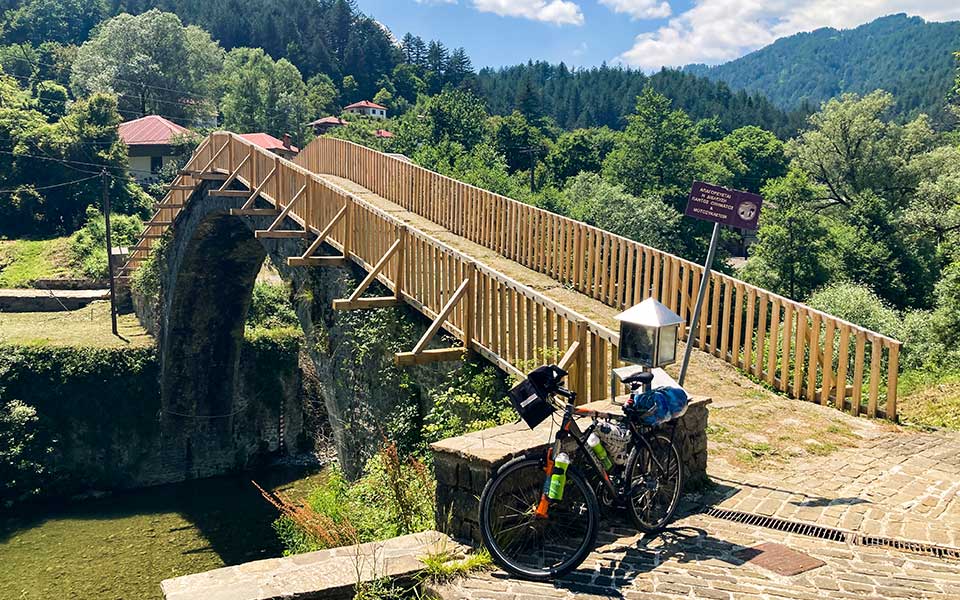
© Giorgos Detsis
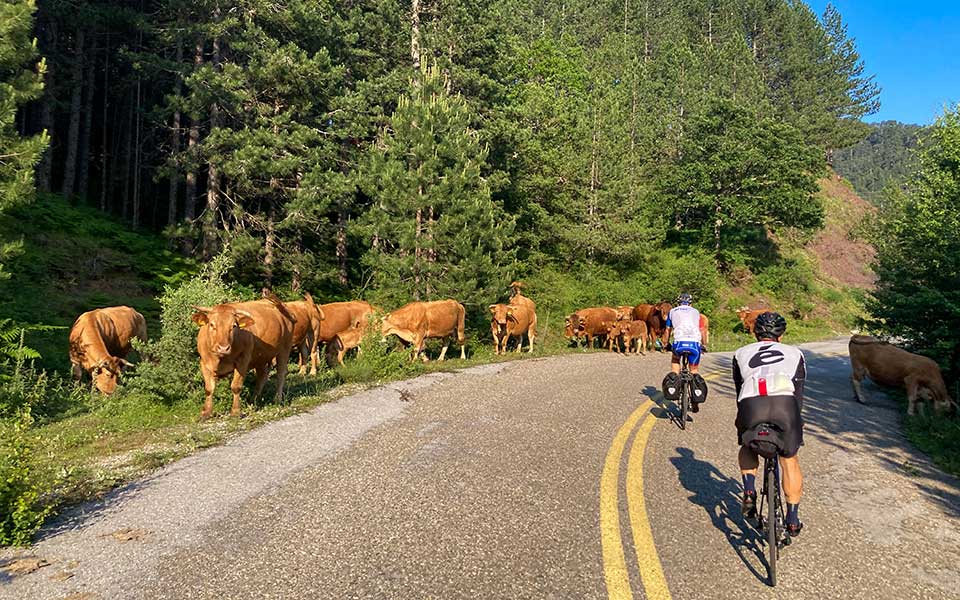
© Giorgos Detsis
Samarina
The morning finds us pedaling slowly along the winding road until the sudden ascent that leads to Lavda. As we stop to fix a deflated tire, the van of the local baker passes by, so we stock up on simits and cheese pies to replenish our calories. The road has a slight ascent and then descends until the valley with its rivers that flow from the village of Vasilitsa. From there, we begin another ascent that reaches Smixi and continues on with turns through pine trees and beech trees until the ski center of Vasilitsa. As we get closer to Samarina, which is located at an altitude of 1,450m, I softly sing to myself the popular folksong “Children of Samarina, why are you dirty?” as I think about our sweaty group of cyclists.
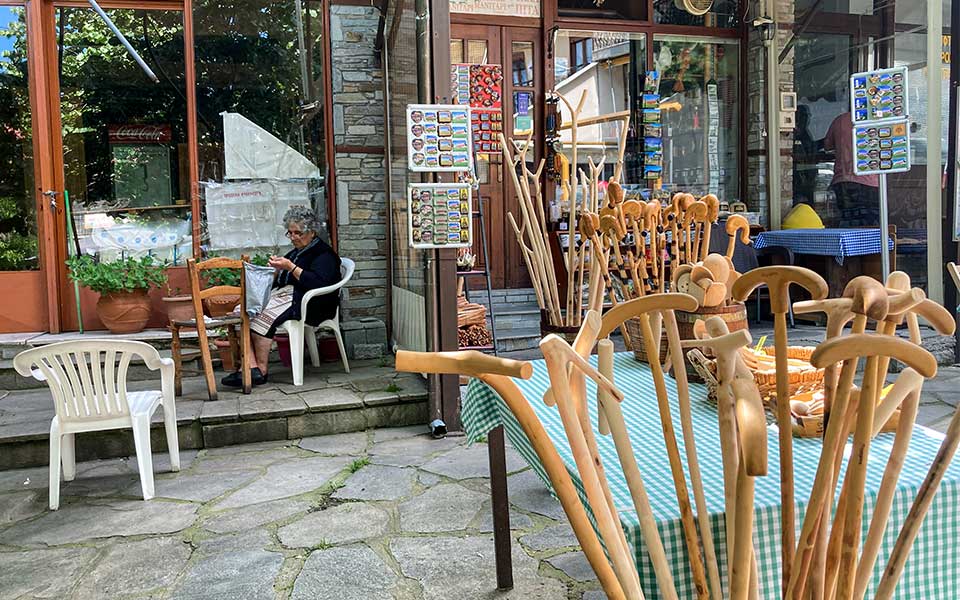
© Giorgos Detsis
We need to regroup and get something to eat at the square with the tavernas, most of which offer dishes with local meats and cheeses. As the afternoon rolls by, the weather begins to shift. In view of the pass that we have ahead of us, we don’t waste any time and start out once again. At various points, the inclines become steeper, forcing us to get off our bikes and push. We move along as a team because the village’s sheepdogs are not happy to see us. Sometimes, we need to get off our bikes and throw water at them and thankfully they leave us alone.
Reaching the pass, the view of the peaks of Mount Smolika – and the ascent – are breathtaking. An easy descent through tufts of beech trees follows, which suddenly becomes steeper with sharp turns until the village of Aghia Paraskevi. We continue on, riding parallel to the Vourkopotamos River until we reach the valley of Sarantaporos. From there, we turn southwest and finally reach Konitsa.
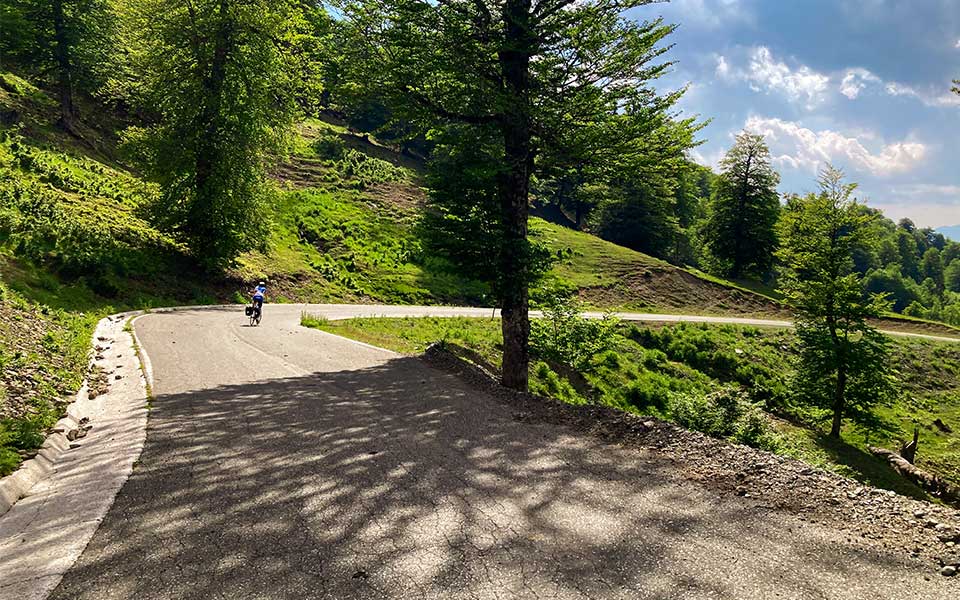
© Giorgos Detsis
Papingo
We leave Konitsa before the break of dawn. At the edge of the town, we stop at the famous single-arch bridge, a beautiful construction that was built in 1869. From the top of the bridge, at a height of 19.25m, we stop to enjoy the beautiful view of the canyon and the slopes of Mount Tymfi. We continue at a fast pace for a few kilometers along the busy Konitsa – Ioannina road until the intersection of the village of Aristi. We’re welcomed by an ascent without any shade, but thankfully it’s still early in the morning so the sun isn’t hot yet.
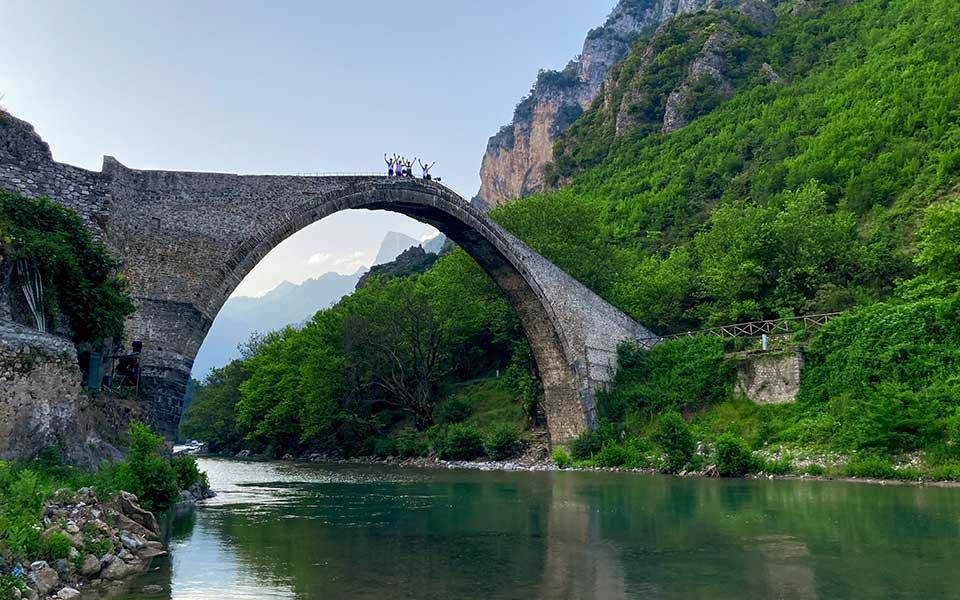
© Giorgos Detsis
We pedal slowly until Aristi where we stop for a snack before descending to the bridge that crosses the Voidomatis River. A dip in the river’s icy waters purifies anyone who is bold enough to withstand the water’s 6°C temperature. Those of us who didn’t have the courage to dive in the water probably regretted it because the ascent to the village of Papingo was one of the most difficult trials of our trip. The 21 sharp tuns that quickly gain altitude, the absence of shade, and the traffic tested our limits. Megalo Papingo is beautiful, but expensive.
However, the view of the imposing rocks of the prominent peak of Astraka that tower over Megalo Papingo and the village’s architecture that is characteristic of the region of Zagori was reward enough. Rightfully so, Megalo Papingo is one of Greece’s top mountain destinations.
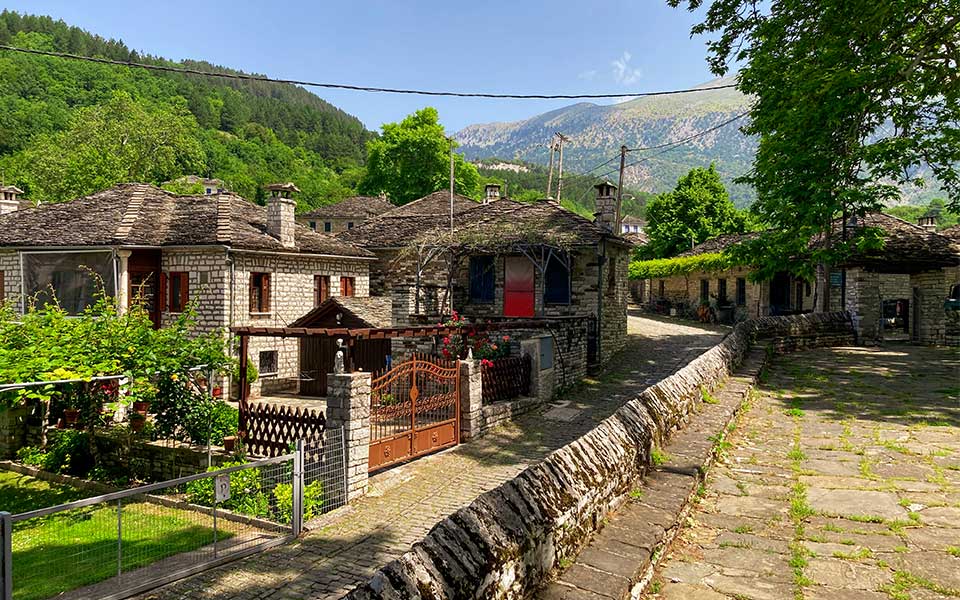
© Giorgos Detsis
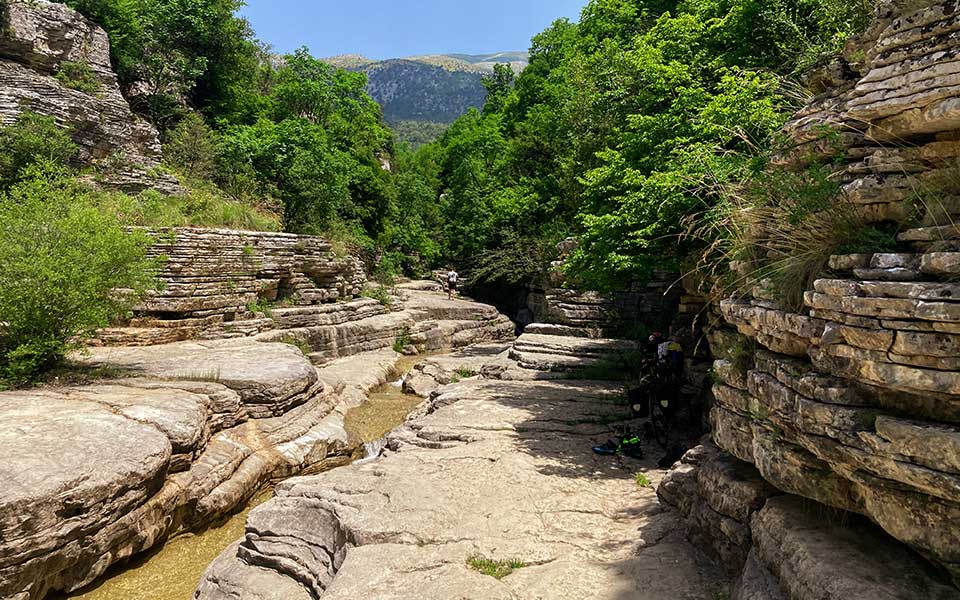
© Giorgos Detsis
After cooling down, we continued on until the rock pools between Megalo Papingo and Mikro Papingo. These natural pools with water that comes down from the mountain – the water is tolerable– rejuvenate us before our ascent to Mikro Papingo. This is where the trail for Drakolimni Lake and the top of Mount Tymfi starts. We return to Aristi to get a bite to eat at the café – restaurant “En Aristi.”
We rest for a while on the low stone walls until the sun dies down and we start off on another ascent until we reach an altitude of 1,000m. From there, we descend to a plateau, passing through Kato Pedina and the church of the Taxiarches. From Aspragelous, a long descent takes us to Metamorfosi on the Kozani – Ioannina road. We travel along the busy road with our lights on for safety. A storm looms ahead of us, but at the last minute it moves west avoiding us altogether. Unfortunately, however, we run into the water that the storm left behind as trucks raise clouds of spray as they pass us by. We reach Ioannina late in the evening and we check in our hotel, take a shower, and rest for the night.
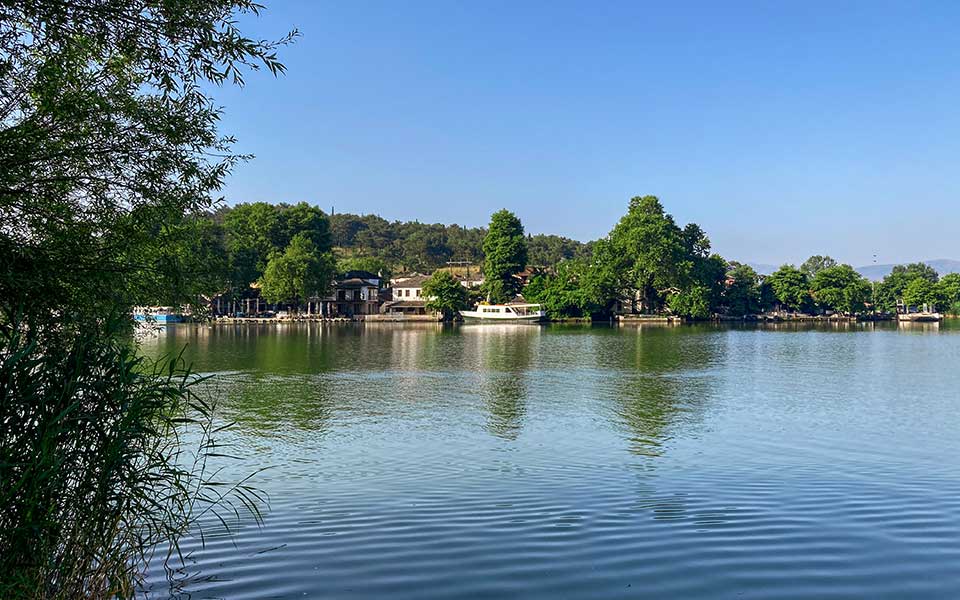
© Giorgos Detsis
Tzoumerka
Early in the morning, like typical tourists, we take a picture in front of the lake’s misty quay, as if we’ve never seen fog before. It is indeed magical! We cycle north around Pamvotida and turn south towards Tzoumerka, which lies ahead of us. The level road passes through fields until the village of Koutselio, it heads east and disappears into the mountains.
We pass the Tsimovou bridge that stands over the Arachtho river where the road with its 27 steep, sharp turns ascends quickly. We pass a monument that is dedicated to the 29 victims of the bus that fell over the cliff in 1958. At noon, we reach Petrovouni, having climbed 750m from the bridge. We don’t find any shops open, so we head to the plane tree at the square. A few meters away the descent begins, leading us to the heart of the mountains through forests that provide welcoming shade. Unfortunately, the cool lasts just a short while because a flat tire traps us in the scorching heat.
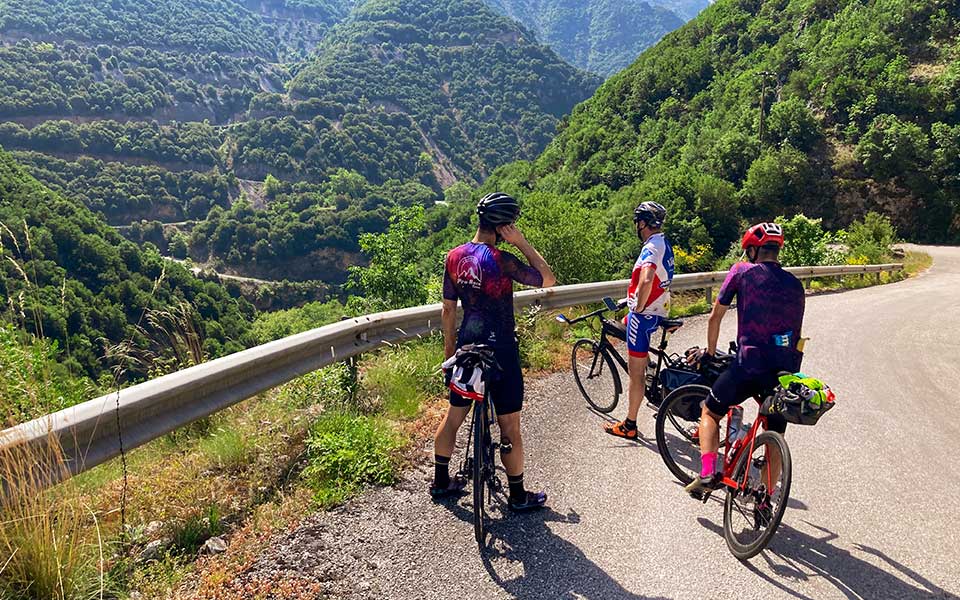
© Giorgos Detsis
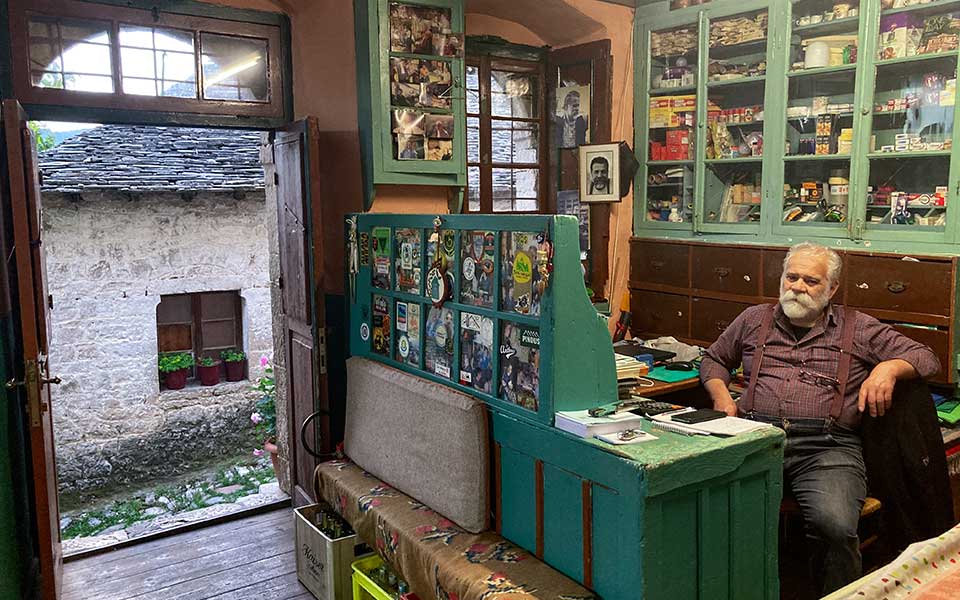
© Giorgos Detsis
As the evening approaches, we reach the quiet village of Prosilio while ominous black clouds start to gather over the surrounding peaks. We take a short break and snack on a nutrient bar and embark on the longest ascent with the steepest inclines that we’ll encounter on our trip, which means that at some points we’ll need to get off our bikes and push. Thankfully, the canyon of the Kalarrytikos River is deep and the sky is cloudy, so the air is cool. At one particular turn, the Kipinas Monastery looks austerely down at us as it hangs perched on the cliff.
A local villager shows us a stream that flows at its base, informing us that the water is potable. We quench our thirst and continue on our journey. Passing through a tunnel and an iron bridge, we climb the mountain slowly, one turn after the other, to Kalarrytes, which, together with Syrrako, are the jewels of Tzoumerka! A Vlach village with beautiful architecture which, like many villages, saw a rise and decline. Napoleon Zaglis welcomes us at his fabulous coffee shop – restaurant, a time capsule that travels you back to a time and place that has been forgotten. Delicious food and a traditional guesthouse with a big balcony with an amazing view and reasonable prices.
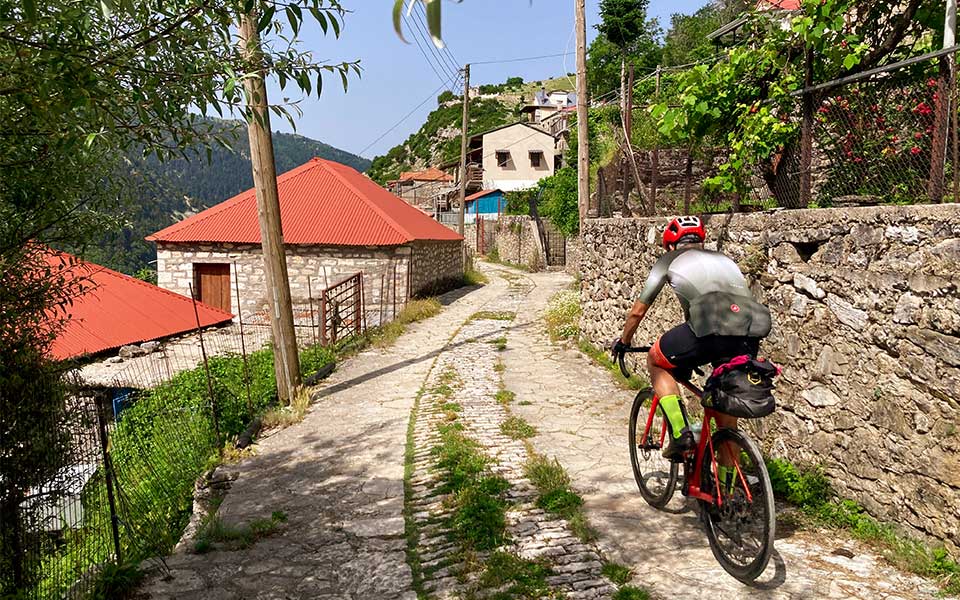
© Giorgos Detsis
Baros
At an elevation of 1,900m, the Baros pass is the highest asphalted pass in Greece, connecting Thessaly with Epirus. The view from the pass is amazing and before we make our way down to the village of Matsouki we stop to take a few photos. As we’re enjoying our ride down through the alpine tundra, a flat tire forces us to stop again. We change the tire and continue on our way, avoiding – with some difficulty –sheepdogs, and finally reach the village of Christoi. We fill our water bottles and continue steadfastly because we have to cover a lot of distance, as well as the highest elevations that we’ll encounter on our journey.
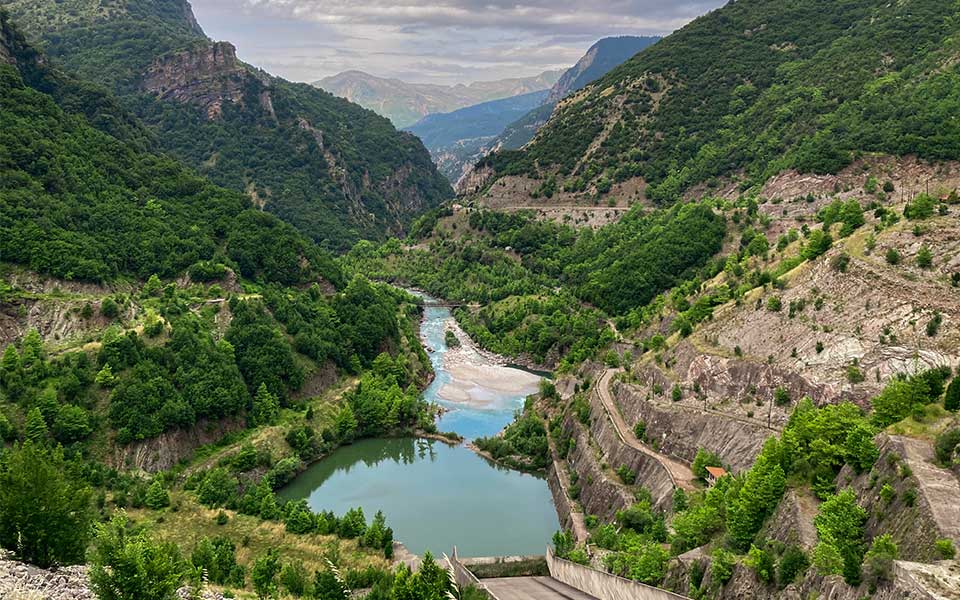
© Giorgos Detsis
Entering Pramanta in the afternoon, we make our way to a bakery to get something to eat and drink, of which we’re so much in need. In Pramanta, we get an unexpected surprise! We run into Orestis, a person who is known among cyclists for his solo trips through the mountains, and have a short chat with him. I go to a couple of supermarkets to buy sunscreen, but I cannot find any. In fact, at the second supermarket I went to, they ask me bewilderedly “Sunscreen in the mountains?” They probably haven’t heard of the harmful effects of sun exposure, which is stronger at higher altitudes. The weather is very hot and humid, so we don’t waste any time because we have a long road ahead of us.
We get on our bikes and ride towards Agnanta with the storm trailing behind us. We pass Ramia and turn left towards Kypseli – towards the storm. Looking up, it seems like the sky is going to fall on our heads. We encounter strong gusts of wind, a sign that a heavy storm is approaching. As we ascend, I look for bus stops, small churches and anything else that can provide us with some shelter. The Gods, however, seem to be on our side and allow us to reach Kypseli just a few minutes before the heavens open. When the storm subsides, we ride up the last forested ascent and then down to Vourgareli where we stay overnight.
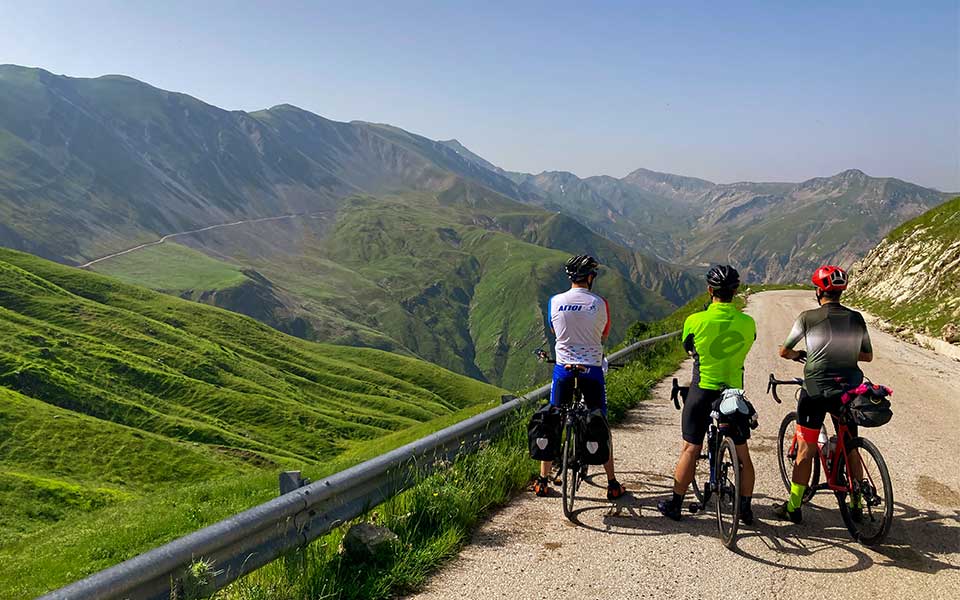
© Giorgos Detsis
The journey back
Our last day is filled with cloudy skies, gentle down hills and unruffled serenity, which promise a pleasant ride. We’re able to cover a lot of distance, but the weather conditions change and it starts to rain. Turning on our lights, we quickly make our way through the tunnels next to the Acheloos River that, albeit dangerous, protect us from the rain. We pass the dam and stop for a while at Mesochora. As we’re leaving the village, a group of children spur us on. The rain continues to fall intermittently, but it’s not enough to make us stop, while the traffic on the road increases. The last tunnel – the Gropa tunnel – marks the beginning of a long descent towards Pyli.
From there, we reach the plain of Trikala, where more rain awaits us. We stop every so often wherever we can to get out of the rain which, upon reaching Trikala, finally stops. There is still one straightaway left until Kalabaka, which seems to have no end as it has an endless small incline and a lot of traffic, with trucks and cars passing closely by us. We pedal with our heads down so we don’t look at Meteora which doesn’t seem to get any closer as time passes, and in a little bit over one hour we finally reach the end of our journey. Our trip ends here, after 7 days, 650km of asphalt road, 15,200 meters of elevation and countless experiences, leaving us with a bitter-sweet exhaustion, but with stronger legs and the mettle of Pindus!

